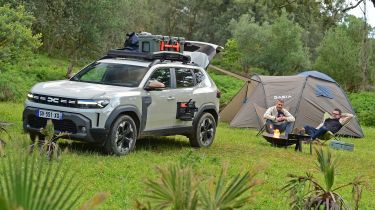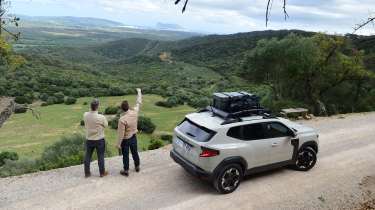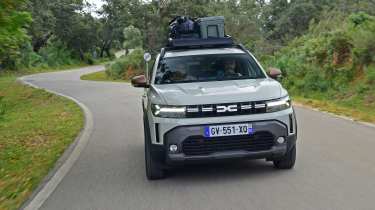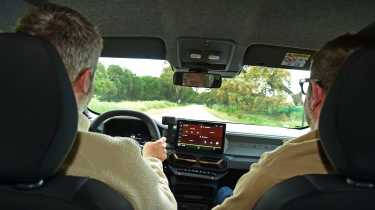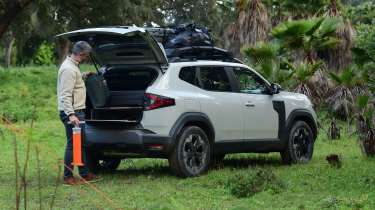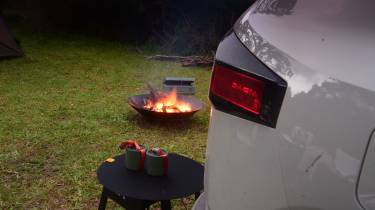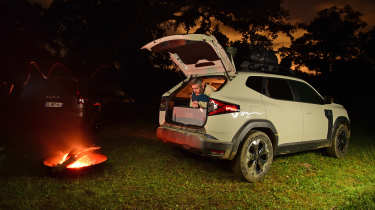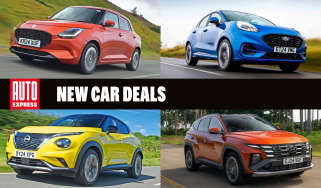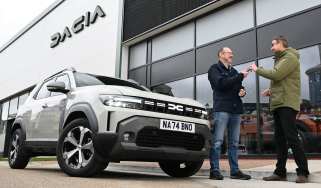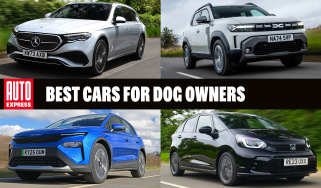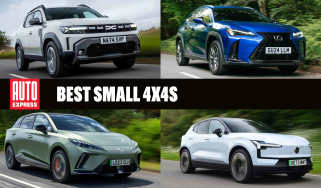Dacia Duster's utility vehicle design vs the Spanish wilderness
We spend a night with Dacia VP of design David Durand, who perfectly embodies the firm’s spirit of adventure
Many car brands trade on an outdoorsy, lifestyle-oriented image. But while we’re all familiar with the term ‘Chelsea Tractor’, Dacia claims its owners embrace their sense of adventure more than most.
It’s part of the reason the maker so quickly introduced Stepway versions of its Sandero supermini (and Logan MCV – remember that?) when the brand launched in the UK over a decade ago. That rougher, tougher look struck a chord with buyers who were looking for SUV style and capability, but at an affordable price point.
Like many of its competitors, Dacia has grown over the past 10 years, aiming ever upwards while retaining that inherent sense of value. The company is beginning to embrace electrification, too, but its cars still display refreshing honesty in a market that’s often overwhelmed by complex technology and nannying safety aids.
To find out what makes Dacia daringly different, we’ve headed to southern Spain to spend a night with self-confessed explorer and VP of Dacia Design, David Durand. On the trip we’ll be among the first in the world not only to drive the new Dacia Duster, but also to sleep in it.
Durand has been with the Renault Group for over two decades. No one understands the design needs of the Dacia brand more acutely, and no one is better informed to discuss its transformation from cheap and cheerful appliance producer, through disruptor, to mainstream maker challenging Europe’s biggest sellers.
Before we talk about the latest Duster and how it was conceived, Durand flicks through his phone, showing me photos of an off-road, off-grid motorcycle adventure he did with friends through Portugal last summer. He’s planning a similar route later this year, running from San Sebastien in the west along the northern edge of Spain. This is a man with a deep love of the outdoors, someone not afraid to ditch luxury for low-impact, low-cost living.
This disregard for the status quo is something he has tried to instil in the next generation of Dacia products. The Duster is the first in a long line of all-new cars due over the coming months and years, and while there are similarities with the old car in its ethos, the design looks very different. Gone is the bulbous, dome-like styling, replaced by sharp lines and strong proportions; Durand says this is a car people will “want to buy”.
His suggestion here is that the Dacia brand has, for some time, built cars that serve a purpose – and get people from A to B – but little else. Going forward, Durand and his team want Dacia to chime with people’s hearts as well as their heads. They don’t want the Duster to be a car you choose because it’s cheap, but rather because it says something about you and your personality.
The company is implementing change at a rate rarely seen at a global car maker this side of Shanghai – due largely to the compact nature of the team and the family-like environment fostered within its highest level of management. The company wants to be seen as a front-runner for sustainability, as Durand points out with reference to the new Duster’s chrome-free exterior.
“Chrome is not clean to produce,” he tells us. “So we said, ‘Why don’t we take off the chrome?’ In a normal company, it would have taken a year to make the decision. But we decided in 10 minutes. We said: ‘No chrome, no leather? Is this a problem for us? No.’ So we took them off.”
It’s that ‘everything you need, nothing you don’t’ mantra that clearly resonates with Dacia customers, and something the business will need to think long and hard about in the not-too-distant future – especially in the transition to hybrid and electric cars.
“With most of our customers, it’s their only car,” Durand tells us. “They are really considering where they put their money. It doesn’t mean they do not have money; they can afford a bigger car, but they make the choice that their car has to remain something simple.”
That simplicity is something that encourages Dacia customers to enjoy their cars to the fullest, too. “People buy a 100,000-Euro Land Rover or whatever, and are too scared to take it off road,” Durand says. “But you don’t have the same worry with a Dacia.”
A big part of our day (and night) with Durand is to experience the car in that environment. Despite our model being a hybrid-equipped 4x2 (front-wheel-drive) variant, we’ve planned a challenging route through the Parque Natural de Los Alcornocales to the west of Marbella in southern Spain.
It’s normally closed to cars, but with special permission, we’re allowed to explore this dramatic landscape – with its stunning views inland, as well as out to the coast and the recognisable outcrop that is Gibraltar. But although our jaws may drop at the surroundings, we’re even more impressed at what light work the Duster makes of Spain’s rocky terrain.
As we’re traversing the steep slopes and slippery rock faces, we can’t help but empathise with Durand’s comments about Dacia’s target market, and why so many people buy Dusters over expensive luxury SUVs – even if money’s not the main driver. It’s at this point that memories of a green-laning trip through west Wales five or six years ago in a then-new Land Rover Discovery come flooding back. The apologetic call to JLR’s press-fleet manager to inform them of two scraped alloy wheels is still ringing in our ears.
We can’t help stopping for picturesque photo opportunities as we climb higher and higher up the dry, rocky roads. Every corner we turn presents a new view; we can see unobstructed for miles and miles, and even spot a thunderstorm brewing in the very distance.
Durand is a very easy bloke to chat to, and most of our journey with him in the passenger seat isn’t spent talking about the car or even the Dacia brand. As the conversation flows, we do feel a little embarrassed to tell him of our plans to decompress by the beach through the summer months; you can’t imagine he’s got much time for sitting still and catching rays.
Before too long, we’re heading back below the clouds to find a quiet spot among some trees that a few of the Dacia team picked out earlier in the week. It’s here where we’ll set up camp, although thankfully the threatening skies pose no problem; we both take comfort in the fact we’ll be sleeping under a tin roof tonight.
While we don’t need to thread poles through canvas, or hammer pegs into the dry ground, Dacia’s Sleep Pack, which has been adapted from the Jogger to fit the Duster, does require a modicum of manual labour. But short of folding the rear seats and fitting a few wooden slats, it’s not complicated. How we’re going to fit through the boot hatch after a few beers, though, remains to be seen.
Having consumed almost half our body weight in crusty bread, Iberico ham and Manchego cheese, we relocate to the campfire – which has been billowing smoke in our eyes for the past hour anyway – where Durand tells us how Dacia’s customer profile influences the cars the firm designs and the models it builds.
“We are not selling to fleets,” he tells us, “but to real people, buying with their money. Dacia owners keep their car for eight years on average – that’s longer than any other brand. After a while, we realised making a good design is not so expensive. I often explain that the most important thing in my job is negotiating with good proportions. If you get the good proportions, [people] like it immediately,” Durand says.
It’s an interesting point as he throws back to his earlier comments about removing the chrome trim from the brand’s latest models: “If we have good proportions, we don’t need styling to cover anything,” he says. “We don’t need make-up; we can make it simple. We can get rid of many little accessories.”
A compelling little nugget that Durand offered up earlier in the day, but that we’re excited to revisit, is the reason behind why the rear door handle is hidden in the C-pillar, instead of being mounted to the metal as before. It’s a common trick on superminis or sports cars – giving something practical the appearance of something sleeker – and we had assumed the Dacia design team were trying to jump on this industry trend.
“It’s not the right car for a three-door design,” Durand says with a smile. “But we were not looking for that. We were not prepared to make our rear fender flat, so what’s the other option? We wanted to have this definition, so we moved the door handle up. We are ready to discuss everything. Every Euro counts,” Durand tells us.
If you look closely, there are examples of this in every area of Dacia design. The way the rear lights are all one piece, for example, directly mounted to the main body rather than the tailgate. “You’d have double bulbs, double wiring, double everything otherwise,” Durand says, and doing without reduces complexity and cost.
We get the sense global manufacturers could learn a lot from Dacia. “It’s really about saving two Euros here, half a Euro there, 10 Euros there,” Durand tells us. “Sometimes we are saving money to put it into the central screen, because you have it in front of you all day. Or the steering wheel; you hold it in your hands, so it’s more important than some other details.
“If the mainstream market has something, do we have to do the same? No, we can do a good design without these things. It’s stimulating for us,” he says.
This simplicity isn’t only about reducing cost at the point of manufacture, though. It’s about passing the savings onto customers, with both a low purchase price and low maintenance costs – something Durand and his active lifestyle personally advocate.
“We have owners who have their Jogger in the garage, and they save so much money they have two carbon-fibre mountain bikes that cost more than their car,” Durand says with measurable enthusiasm.
“And they don’t care. They love it,” he tells us. “It’s about deciding what you want to do with your life, with your money. You can decide it’s more important to extend your house, or pay your daughter’s university fees. There are more and more people saying, ‘Okay! Have you seen the new Dacia? It’s pretty cool.’”
Before long, it’s time to retire to our respective cars. As mentioned, while Jogger drivers have been enjoying the Sleep Pack in their cars for some time, we’re the first to try the lightly revised set-up in the latest Duster.
It’s a bit of a squeeze, admittedly – especially because after getting comfortable, we feel the need to switch ends due to a glowing green LED for the e-call system doing its best to keep us awake. But there’s plenty of cushion in the mattress, and even with clear skies on a cool spring evening, we don’t feel the cold. Mind you, that might be more due to the expensive 10-tog sleeping bag than the Duster’s extensive thermal insulation.
Perhaps most surprising, however, is how the window covers keep every last slice of daylight from entering the cabin. Indeed, it could be midnight when we’re awaken by our 07:00 alarm; it really is that dark inside the car.
The biggest issue is that the Sleep Pack consumes the entire boot when it’s folded away. If you have your partner or kids in tow, then their luggage will need to sit next to them – or on the optional roof rack fitted to our test car. But we’ll admit that if you want your SUV to double as a campervan, then there’s little way to avoid this.
As we surface, we’ve one last question for Durand, reflecting on our last 24 hours in and around the new Duster. Why hasn’t anyone replicated what Dacia does?
“I think there is a natural way of building cars,” he tells us. “Every time better, more expensive; more content, more features. It’s not natural to make the opposite.”
Yet the success of Dacia and its products proves that if you have the economies of scale, and the support and resources of a giant organisation like the wider Renault Group, then there’s profit to be made on the flip side of normality. And with a design chief like Durand embracing the concept, it’s easy to see the success continuing.
Now read our Dacia Duster off-road test...
Find a car with the experts

